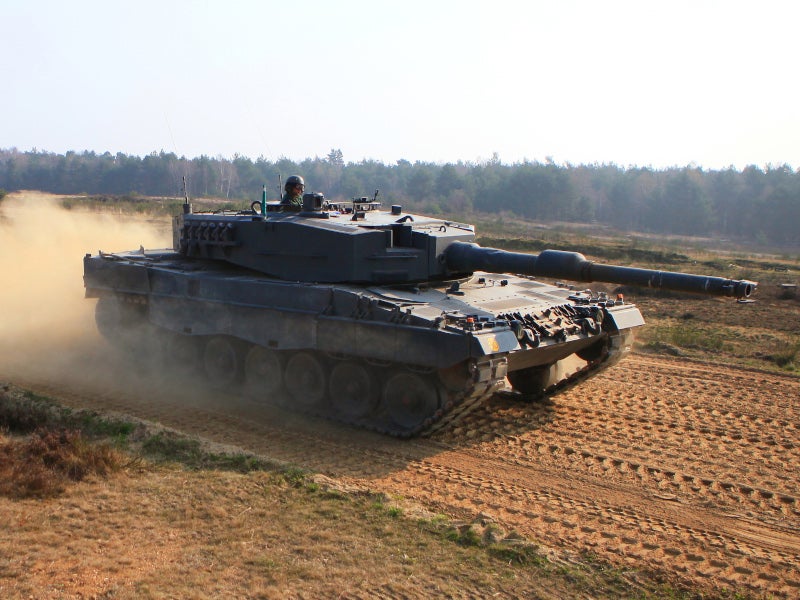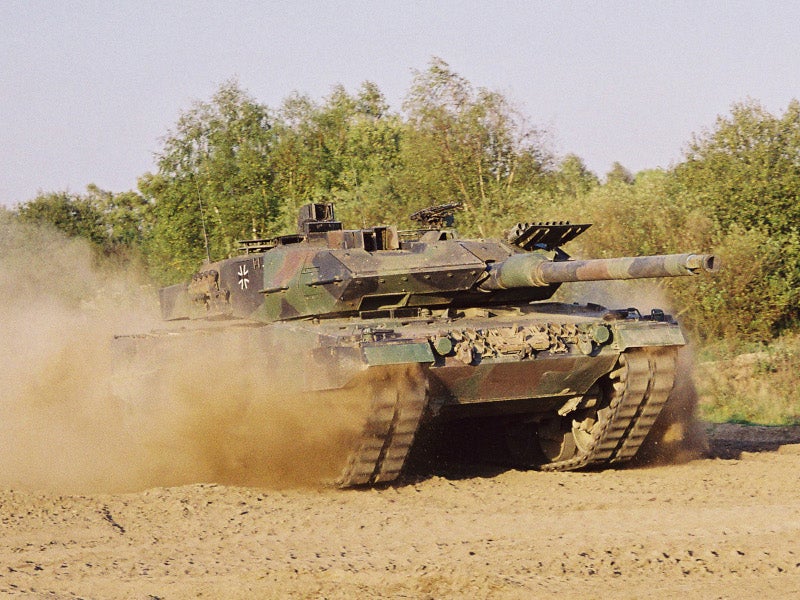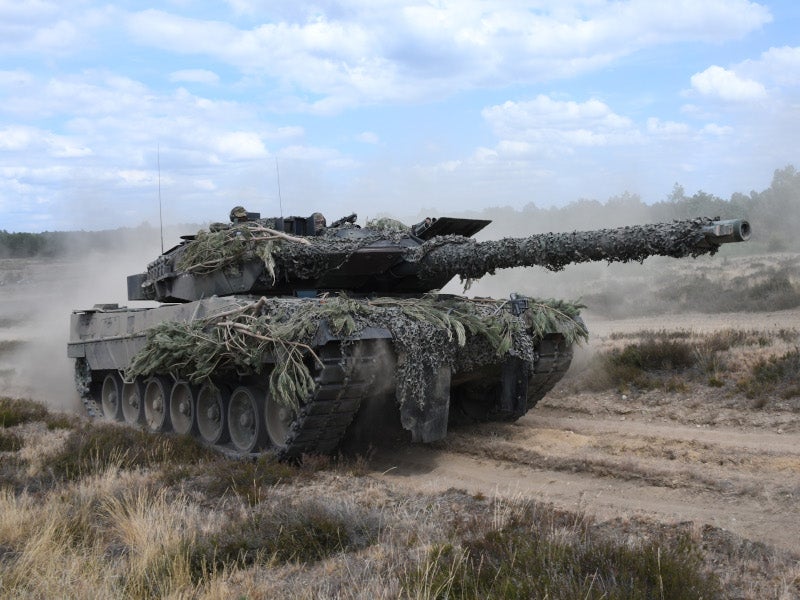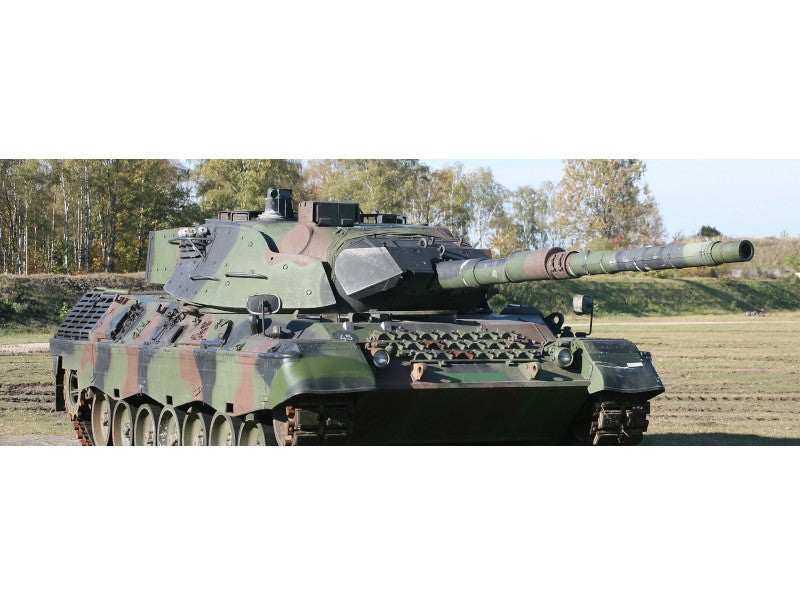Leopard 2 main battle tank was developed by Krauss-Maffei, now Krauss-Maffei Wegmann (KMW), of Munchen, Germany. The Leopard 2 is a successor to the successful Leopard 1.
Leopard 1 was first produced in 1963 by Krauss-Maffei for the German Ministry of Defence. More than 6,000 vehicles have been exported to Belgium, Denmark, Germany, Greece, Italy, Canada, the Netherlands, Norway, Turkey and Australia.
The successor to the Leopard 1, the Leopard 2, was first produced in 1979 and is in service with the armies of Austria, Canada, Chile, Denmark, Finland, Germany, Greece, the Netherlands, Norway, Poland, Portugal, Singapore, Switzerland, Sweden, Spain and Turkey, with more than 3,200 tanks produced.
In June 2010, KMW unveiled its next-generation main battle tank, Leopard 2 A7+. The tank was successfully tested and qualified by the German Army. Its main features include a modular protection kit, improved sustainability and increased mobility.
The other variants of the Leopard MBT are Leopard 2 A6M, Leopard 2 A5, Leopard 2 A4, and Leopard 1 A5.
Mine protection system for improved crew safety
KMW developed a mine protection system for the Leopard 2 tank, following a concept by an international working group led by Germany’s procurement agency BWB, with members from Germany, Switzerland, the Netherlands, Sweden, and Norway.
In September 2003, an order was placed for the modification of 15 Leopard 2A6 tanks for the German Army and ten Leopard 2A5 for Sweden. The first mine-protected tank was delivered in July 2004.
Trials in February 2004 proved the armour package enables Leopard 2 crews to survive an anti-tank mine blast beneath the tank without suffering any injuries.
Construction of the Leopard 2 battle tank
The Leopard 2’s hull is divided into three sections: the driver’s compartment at the front, the central fighting compartment, and the rear engine compartment.
The driver’s compartment includes three periscopes for observation, with ammunition storage to the driver’s left. A rear-mounted camera with a 65-degree field of view and a television monitor assist the driver when reversing.
The turret, positioned centrally, benefits from an upgrade programme that adds third-generation composite armour and further reinforcement to its frontal and lateral sections with external armour modules.
A spall liner inside mitigates fragments spread upon armour penetration and provides noise and thermal insulation, offering protection against multiple strikes, kinetic energy rounds, and shaped charges.
Fire control capabilities of the main battle tank
The commander’s station features an independent PERI-R 17 A2 panoramic periscope sight from Rheinmetall Defence Electronics and Zeiss Optronik, offering 360-degree day/night observation and target identification.
The thermal image from this periscope can be displayed on a monitor and integrated into the fire control system for weapon firing, allowing both commander and gunner to share the same combat range view.
The gunner’s station is fitted with an EMES 15 dual magnification stabilised primary sight from Rheinmetall Defence Electronics, including a laser rangefinder and a Zeiss Optronik WBG-X thermal sight, both linked to the fire control computer.
The thermal sight uses standard US Army common modules, with 120-element cadmium mercury telluride, CdHgTe infrared detector array operating in the eight to 14-micron waveband. The infrared detector unit is cooled with a Stirling closed-cycle engine.
The sight is fitted with a CE628 laser rangefinder from Zeiss Optronik. The laser is a Neodinium Yttrium Aluminium Garnet, (Nd:YAG) solid state laser.
The CE628 laser rangefinder from Zeiss Optronik uses a Nd:YAG laser, providing range data with an accuracy of 20m for up to 10,000m.
For anti-helicopter operations, a first echo selection technique is employed, and the main weapon features electronic firing to reduce reaction times.
Main armaments and weapons on Leopard 2
The Leopard 2 has been upgraded with a 120mm L55 Gun from Rheinmetall Waffe Munition, offering increased projectile velocity, range, and armour penetration over the previous L44 gun. The L55 is compatible with existing 120mm ammunition and newer high-penetration rounds.
Rheinmetall Waffe Munition developed the LKE 2 DM53 kinetic energy ammunition to meet tactical requirements, allowing the L55 to fire up to 5,000m.
The DM53 round’s effectiveness comes from its penetrator length, projectile mass, impact velocity, and interaction with the target, featuring heavy tungsten powder in a monoblock structure and achieving muzzle velocities over 1,750m/s.
Leopard 2 is equipped with a hybrid navigation system from LITEF, a Northrop Grumman subsidiary, combining GPS and inertial navigation.
KMW’s MBT Leopard 2 support systems and tank engine
An upgrade programme has introduced the E-WNA electrical weapon follow-up system, replacing the H-WNA hydraulic system.
This change offers numerous benefits, including the absence of pressurised hydraulic fluid, reduced noise, power consumption, and heat generation, as well as enhanced reliability, maintenance, operational cost savings, and better long-term storage.
The crew compartment features a fire and explosion detection and suppression system licensed by Deugra Ges. fur Brandschutzsysteme by UK’s Kidde-Graviner, with a fireproof bulkhead separating it from the engine compartment.
The Leopard 2’s power comes from an MTU MB 873 diesel engine, producing 1,100kW, coupled with a Renk HSWL 354 transmission. Trials have been conducted with an enhanced EuroPowerPack featuring a 1,210kW MTU MT883 engine.
The engine is the MTU MB 873 diesel engine, providing 1,100kW, with a Renk HSWL 354 gear and brake system. An enhanced version of the EuroPowerPack, with a 1,210kW MTU MT883 engine, has been trialled on the Leopard 2.
Orders and deliveries for Leopard 2
The Finnish Army has acquired 124 tanks while the Polish Army has purchased 128 used Leopard 2A4 tanks from Germany. In August 2005, Greece ordered 183 used Leopard 2A4s and 150 Leopard 1A5 tanks from German Army reserves.
In November 2005, Turkey agreed to buy 298 German Army Leopard 2A4 tanks. Chile placed an order for 140 Leopard 2A4s from Germany in March 2006, with the first delivered in December 2007.
Germany upgraded 225 2A5 tanks to 2A6s, with the first delivered in March 2001. The Netherlands upgraded 180 2A5s to 2A6s, with the first vehicle entering service in February 2003.
In March 2003, Greece ordered 170 Leopard 2 HELs, with the first 30 assembled by KMW and the rest by Greece’s ELBO. The first Greek-built tank was delivered in October 2006, and the 2A6 HEL entered service in May 2008.
Spain ordered 219 Leopard 2Es (2A6 variant with increased armour), 16 recovery tanks, and four trainers. KMW built the first 30, and General Dynamics, Santa Barbara Sistemas licensed the rest in Spain. The first Spanish tank arrived in June 2004, with deliveries concluding in 2008.
The Leopard 2(S) for the Swedish Army features a new command system and passive armour, with 120 units delivered by March 2002.
Singapore bought 66 refurbished Leopard 2A4s plus 30 for spares from Germany in December 2006, which entered service in September 2008.
In April 2007, Canada purchased up to 100 Leopard 2s from the Dutch and leased 20 Leopard 2A6Ms from Germany, with the first 2A6M delivered in August 2007 and deployed to Afghanistan later that month. The Dutch retain 110 2A6 tanks.
Portugal bought 37 Leopard 2A6s from the Dutch Army in October 2007, with the first eight delivered in October 2008 and deliveries concluding in 2009.
In October 2010, Canada received the first 20 modernised Leopard 2A4M CAN tanks from KMW, five of which were sent to Afghanistan in January 2011 as replacements for the 2A6M CANs deployed since 2007.
In July 2011, a deal to sell around 200 Leopard 2 A7+ to Saudi Arabia was approved by Germany’s Federal Security Council.
In November 2013, Indonesia’s Ministry of Defence ordered $289.6m worth of vehicles and support from Rheinmetall, including 103 refurbished Leopard 2 tanks and 42 upgraded Marder 1A3 infantry fighting vehicles. The first eight Leopard 2 RI tanks arrived in May 2016.
Rheinmetall secured a €220m ($238.9m) order from Poland in February 2016 to upgrade 128 Leopard 2 MBTs to the 2 PL standard, and in December 2018, Hungary ordered 44 Leopard 2A7+ tanks. The first tank was delivered in December 2023.
A €118m ($139.3m) contract was awarded to Rheinmetall in 2017 to modernise 104 Leopard 2 tanks for the Bundeswehr to the A7V standard.
In December 2017, Saab received an order from KMW for mobile camouflage systems for Leopard 2 tanks, with deliveries spanning 2018-2022.
In April 2019, KMW was contracted for over €300m to upgrade 101 Leopard 2 A6 tanks, with deliveries expected to be completed by 2026.
In February 2023, the Norwegian Defence Materiel Agency ordered 54 Leopard 2 A7 NOR tanks with an option for 18 more in a contract valued at €129m. Deliveries are expected to occur between 2026 to 2028.
In May 2023, BWB contracted KMW for 18 Leopard 2 A8 MBTs with options for an additional 105 tanks and a comprehensive service package, with deliveries starting in 2025. The tanks will replace units provided to Ukraine.
In November 2023, the Swedish FMV began modernising its Leopard 2 fleet, with 44 vehicles to be retrofitted by 2026 and an option for the full fleet upgrade, including firepower, protection, and digitalisation enhancements.
In December 2023, Leonardo and KNDS agreed to strengthen their partnership under the Italian Ministry of Defence’s guidance, aiming to form a European Defence Group and advance armoured vehicle platforms, including the MGCS. Leonardo and KNDS will jointly pursue Italy’s Leopard 2 A8 MBT procurement programme, focusing on development, production, and maintenance.
In February 2024, KNDS announced that the Swedish Armed Forces would adopt its advanced simulators for Leopard 2 training, with 18 high-fidelity simulators to be delivered for comprehensive training across Sweden.





